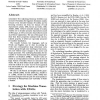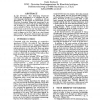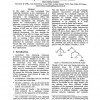ACL
2012
12 years 10 months ago
2012
Recently, it was shown (KUHLMANN, SATTA: Tree-adjoining grammars are not closed under strong lexicalization. Comput. Linguist., 2012) that finitely ambiguous tree adjoining gramm...
ACL
2009
14 years 5 months ago
2009
This paper investigates the class of TreeTuple MCTAG with Shared Nodes, TTMCTAG for short, an extension of Tree Adjoining Grammars that has been proposed for natural language proc...
COGSCI
2004
14 years 7 months ago
2004
Disfluencies include editing terms such as uh and um as well as repeats and revisions. Little is known about how disfluencies are processed, and there has been next to no research...
COLING
1990
14 years 8 months ago
1990
Lexicalized Tree Adjoining Grammar (LTAG) is an attractive formalism for linguistic description mainly because cff its extended domain of locality and its factoring recursion out ...
ACL
1990
14 years 8 months ago
1990
In the literature, Tree Adjoining Grammars (TAGs) are propagated to be adequate for natural language description -- analysis as well as generation. In this paper we concentrate on...
EACL
1993
ACL Anthology
14 years 8 months ago
1993
ACL Anthology
We study parsing of tree adjoining grammars with particular emphasis on the use of shared forests to represent all the parse trees deriving a well-formed string. We show that ther...
ACL
1996
14 years 8 months ago
1996
In this paper 1 we present a new parsing algorithm for linear indexed grammars (LIGs) in the same spirit as the one described in (Vijay-Shanker and Weir, 1993) for tree adjoining ...
COLING
2000
14 years 9 months ago
2000
We present a class-based approach to building a verb lexicon that makes explicit the close association between syntax and semantics for Levin classes. We have used Lexicalized Tre...
ACL
1998
14 years 9 months ago
1998
Several methods are known for parsing languages generated by Tree Adjoining Grammars (TAGs) in O(n 6) worst case running time. In this paper we investigate which restrictions on T...
ACL
1998
14 years 9 months ago
1998
In this paper we view Lexicalized Tree Adjoining Grammars as the compilation of a tract and modular layer of linguistic description :the metagrammar (MG). MG provides a hierarchic...



